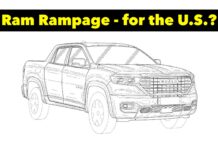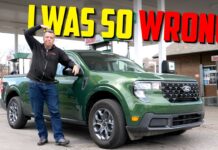So, you’re in the market for a brand-new small truck. But which one should you buy?
While you’re flush with choice if you decide to buy a midsize or half-ton truck and always have the Big Three when it comes to HD options, small trucks…well, it’s just Ford and Hyundai at the moment if you’re looking in the U.S. Nevertheless, the duopoly of Maverick and Santa Cruz has proven popular, with more than 160,000 sales between them last year. That figure heavily favors the Blue Oval by about four-to-one — Ford sold 131,142 Mavericks while Hyundai dealers shifted 32,033 examples — so the Maverick is the better option, right? In the video below, Roman takes a closer look at both trucks.
It’s not quite as obvious as the headline suggests (hey, it has to be something catchy so you guys actually click-in and watch it). Even with Ford’s substantial lead in the sales charts, the recently refreshed Hyundai Santa Cruz could be a great fit for certain kinds of owners. So, let’s take a look at the side-by-side numbers before delving into the nitty-gritty of splitting the two.
2025 Ford Maverick vs. Hyundai Santa Cruz by the numbers:
| Ford Maverick | Hyundai Santa Cruz | |
|---|---|---|
| Starting Price (Base MSRP) | $25,515 (EcoBoost); $27,265 (Hybrid) | $30,600 (SE) |
| Top-End Price (Highest spec, powertrain) | $36,555 (Lariat, 2.0L EcoBoost) | $44,100 (Limited, 2.5L turbo) |
| Powertrain Options | 2.0L EcoBoost I-4 or 2.5L I-4 Hybrid | 2.5L I-4 (naturally aspirated or turbocharged) |
| Transmission | eCVT1 (Hybrid), 8-spd auto (EcoBoost) or 7-spd auto (Lobo AWD)2 | 8-spd auto (NA) or 8-spd dual-clutch (Turbo) |
| Horsepower Range | 191 (Hybrid) – 238 (EcoBoost) hp | 191 (NA) – 281 (Turbo) hp |
| Torque Range | 155 (Hybrid) – 275 (EcoBoost) lb-ft. | 181 (NA) – 311 (Turbo) lb-ft. |
| Curb Weight Range | 3,674 – 3,731 lbs. | 3,778 – 4,237 lbs. |
| GVWR Range | Hybrid: 5,320 lbs. EcoBoost: 4,970 – 5,240 lbs. (trim dependent) | NA: 5,522 (FWD) – 5,665 (AWD) lbs. Turbo: 5,798 lbs. |
| Fuel Economy (City/Hwy/Combined mpg) | 42 / 33 / 37 (Hybrid FWD)3 40 / 31 / 35 (Hybrid AWD)3 23 / 30 / 26 (EcoBoost FWD)3 22 / 29 / 25 (EcoBoost AWD)3 24 / 20 / 21 (Tremor AWD)3 | 22 / 30 / 25 (NA FWD) 21 / 29 / 24 (NA AWD) 19 / 27 / 22 (Turbo AWD) 18 / 26 / 21 (XRT) |
| Fuel Tank Capacity | 13.8 gal. (2.5L Hybrid) 16.5 gal. (2.0L EcoBoost) | 17.7 gal. |
| Wheelbase | 121.1 in. | 118.3 in. |
| Length | 199.8 – 200.9 in. (trim dependent) | 195.7 – 195.9 in. (XRT is longer) |
| Width (excluding mirrors) | 72.6 in. | 75 in. |
| Height | 67.7 – 69.4 in. (trim dependent) | 66.9 in. (w/ roof rails) |
| Cargo Bed Length | 54.4 in. (4-1/2 ft.) | 48.4 (upper) – 52.1 (lower) in. |
| Cargo Bed Width (Max, at floor) | 53.3 in. | 53.9 in. |
| Cargo Bed Depth | 20.3 in. | 19.2 in. |
| Lift-in Height | 28.2 – 30.4 in. (trim dependent) | 31.9 in. |
| Ground Clearance | 8.3 inches | 8.6 in. |
| Towing Capacity | 2,000 (standard) – 4,000 lbs. (w/ 4K Tow Package)4 | 3,500 (FWD) – 5,000 (AWD) lbs. |
| Payload Capacity | Hybrid: 1,400 (AWD) – 1,500 (FWD) lbs. EcoBoost: 1,045 (Lobo) – 1,140 (Tremor) – 1,500 (other AWD trims) lbs. | 1,411 lbs. |
| Final Assembly Location | Hermosillo, Sonora, Mexico | Montgomery, Alabama, USA |
2. The Maverick Lobo’s 7-speed 7F40 automatic from the European Ford Focus ST, rather than the 8F35 on other EcoBoost models;
3. Official EPA figures for the 2025 Ford Maverick have not published yet; these are 2024 figures and estimates for the 2025 Hybrid AWD;
4. The 4K Tow Package is not available on Tremor or Lobo trims.
So…which one is better?
Coming at these trucks by the numbers reveals a few key differences between the two — namely that the 2025 Hyundai Santa Cruz is generally more expensive (going by base and high-end MSRPs, at least), while the Maverick offers a far more fuel efficient option for small truck buyers. As far as physical dimensions, there are only a few inches here or there.
In our experience with the Hyundai Santa Cruz, the 2.5-liter turbo engine offers a good amount of punch for the money, so you could argue it’s the more “fun” truck to drive day-to-day. That 8-speed dual-clutch transmission, on the other hand, brings some tradeoffs to the equation. DCTs are great to use…on race tracks.
On a small truck or crossover? Not so much, as it can be a bit jerky at slow speeds and has a tendency to overheat when you take it off-road. That said, Hyundai is a bit more out there with the styling and how it presents the Santa Cruz’s technology, whereas the Maverick is a bit more utilitarian and truck like, as far as everything is laid out (as you’d probably expect). That said, going for the turbo engine does increase the towing capacity to 5,000 pounds, whereas the naturally aspirated models cap out at 3,500 pounds.
The 2025 Ford Maverick is a game-changer from pre-facelift models for a couple reasons. Not only did the EcoBoost lineup expand with the street-focused Lobo, but you can now get the hybrid with all-wheel drive. That essentially offers the best all-around choice — decent (if not blistering) performance, excellent fuel economy and versatility all wrapped up in one package. It’s certainly no sports car, though you can still get the 2.0-liter EcoBoost if you want to sacrifice gas mileage for more pep, but most people don’t need something that can race away from the lights at every opportunity.
Instead of the 8-speed auto in the Hybrid, too, you get Ford’s “eCVT” setup. This is not a conventional belt-driven CVT, but rather uses a planetary gear set controlled by electronic modules. The goal, at least, is to provide a setup that’s more robust and applicable to truck use than the thought of snapping that expanding drive belt on your usual CVT. That could come in useful considering even the Maverick Hybrid can tow up to 4,000 pounds when properly equipped.
Check out more details in the video below
As frustrating as the whole “it depends” answer may be, when shopping between the 2025 Ford Maverick and Hyundai Santa Cruz…yeah, it depends. Ford — being the perennial truck builder — seems to be winning the sales race by offering up a smaller, more affordable alternative to any of the midsize or larger trucks.
That’s not to say the Hyundai Santa Cruz is bad: It isn’t. It is a bit different and leans more toward your “lifestyle vehicle” than your out-and-out fleet-mobile or workhorse, but I’d definitely recommend testing both out if you’re stuck deciding between the two.




















![Which is More Reliable: 3.5L EcoBoost or 5.0L V8? [Reader Question] Second-generation 3.5-liter EcoBoost engine](https://tfltruck.com/wp-content/uploads/2016/05/Second-generation-35-liter-EcoBoost-engine.jpg)
![Which Silverado Engine to Get: 5.3L or 6.2L V8? [Ask TFLTruck] 2016 chevy silverado](https://tfltruck.com/wp-content/uploads/2015/10/2016-chevy-silverado-grille.jpg)
